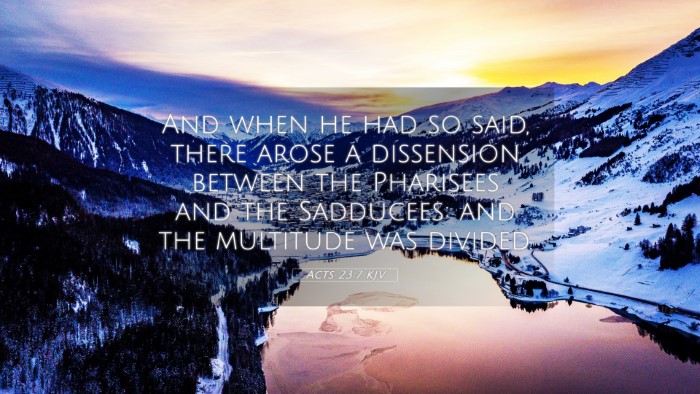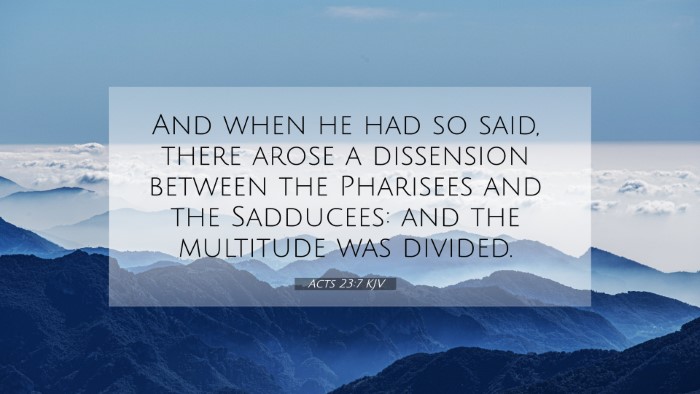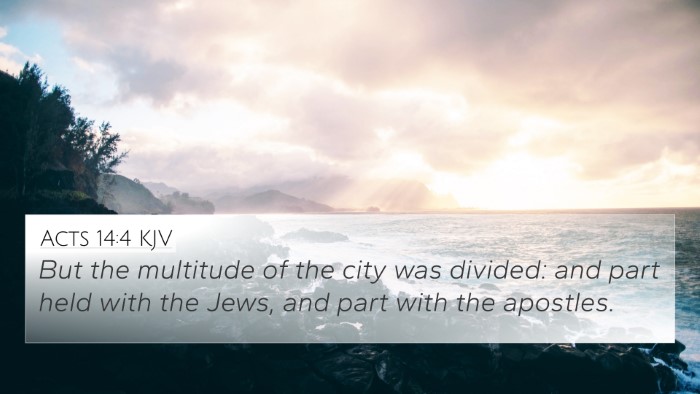Understanding Acts 23:7
Acts 23:7 states: "And when he had so said, there arose a dissension between the Pharisees and the Sadducees: and the multitude was divided." This verse captures a moment of theological debate among early Jews demonstrating the ongoing conflict between different religious sects.
Contextual Overview
This account takes place during Paul's defense before the Jewish council. After Paul identifies himself as a Pharisee, he creates a rift between the two opposing factions: the Pharisees, who believed in the resurrection, and the Sadducees, who denied it. This division reflects the broader themes of belief and conflict found throughout the New Testament.
Commentary Insights
Matthew Henry's Commentary
According to Matthew Henry, this verse illustrates a significant turning point where Paul, through his statement, skillfully directs the focus away from himself to the theological dispute, thus ensuring his safety for the moment. It emphasizes the importance of the resurrection, a core belief for the Pharisees which contrasts sharply with the Sadducees' views.
Albert Barnes' Notes
Barnes states that this event highlights the internal struggles within the Jewish leadership. He notes that the division is not merely a matter of opinion but a crucial theological stance that dictated the beliefs and practices of these groups. Paul takes advantage of this disagreement, showcasing not only his astute understanding but also implying the need for the resurrection in Christian doctrine.
Adam Clarke's Commentary
Adam Clarke emphasizes the significance of resurrection in the teachings of Jesus and Paul. He narrates that the Sadducees' denial of resurrection leads to their eventual downfall, as early Christians began to establish doctrine based upon the resurrection of Christ, a pivotal event in Christian faith. Thus, this conflict serves a greater purpose in the narrative of salvation history.
Thematic Connections
- Resurrection and Belief: Acts 23:7 represents the centrality of resurrection in Christian belief as seen through contrasts in these foundational groups.
- Conflict as a Catalyst: The dissension illustrates how conflict can serve to reveal deeper theological truths.
- Paul's Defense: This event is a strategic part of Paul's defenses, aligning with other scriptural instances where he utilizes discourse to protect himself, such as Acts 22:1-2.
Bible Verse Cross-References
- Matthew 22:23-33: Jesus converses with the Sadducees about the resurrection, emphasizing its reality.
- Acts 4:1-2: The apostles preach the resurrection, provoking similar divisions among the religious leaders.
- Acts 15:5: The Pharisees rise again, showcasing their theological stance in the early church's debates.
- 1 Corinthians 15:12-22: Paul addresses resurrection directly, further developing the discourse that began in Acts 23.
- Luke 20:27-40: Here, the Sadducees challenge Jesus directly, illustrating their denial of the resurrection which parallels their conflict with the apostles.
- John 11:23-26: Jesus' declaration of being the resurrection underscores the vital belief that divides these sects.
- Romans 1:4: Paul emphasizes the resurrection of Christ as proof of His divine nature, a theme crucial to the ecclesiastical disputes outlined in Acts.
Conclusion
Acts 23:7 not only serves as a historical account of Paul’s defense but also occupies a pivotal place in the doctrine of resurrection theology. The dissension it describes between the Pharisees and Sadducees reveals the foundational conflicts that would ultimately shape early Christian beliefs and practices. By cross-referencing this verse with other associated texts, one can gain deeper insight into the significance of resurrection in apostolic teaching and its implications for the faith community.
Further Study and Reflection
For those interested in exploring the connections between Bible verses or engaging in a cross-reference Bible study, Acts 23:7 serves as an excellent starting point. Utilize tools such as a Bible concordance or cross-reference guide to delve into a comparative analysis of Pauline theology and its relation to early Judaic beliefs.
Additional Resources
Consider integrating themes from this verse with those found in related scriptures for enriched sermon preparation and personal study. Engaging with the Bible cross-reference system fosters a comprehensive understanding of Bible verses that relate to each other.






